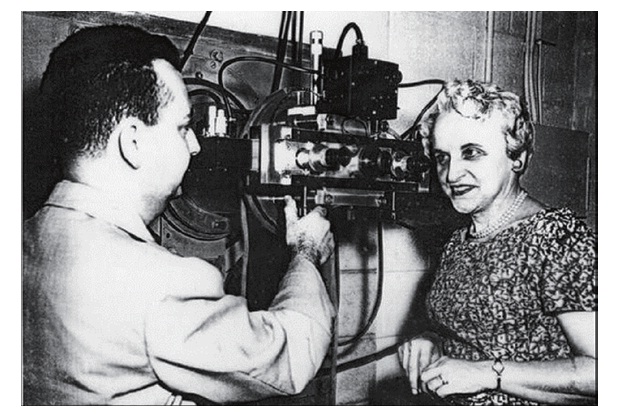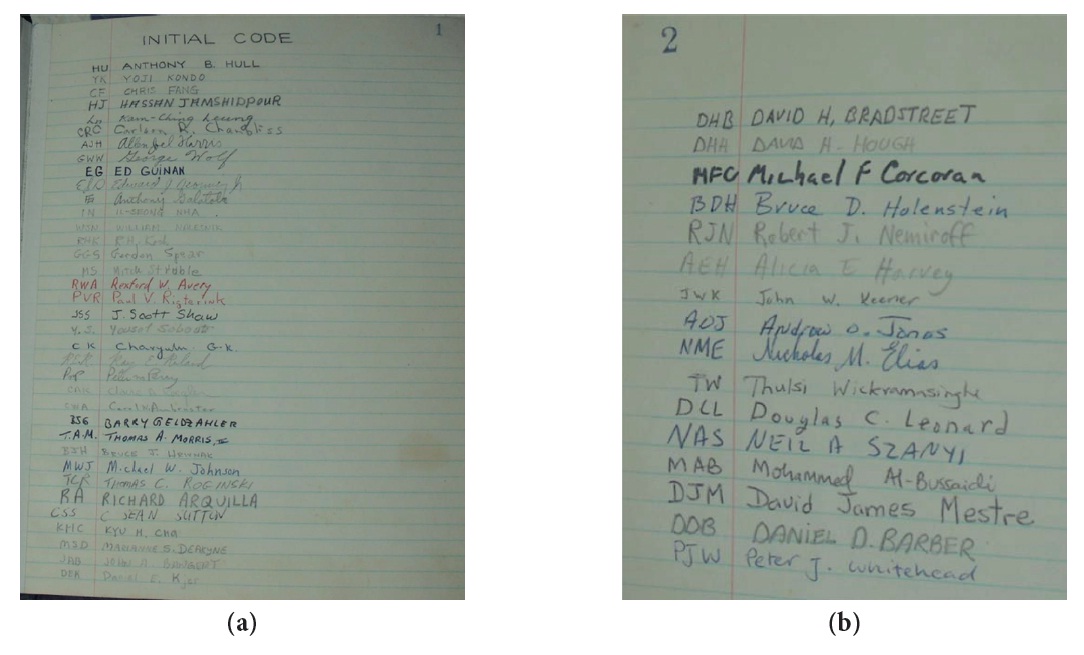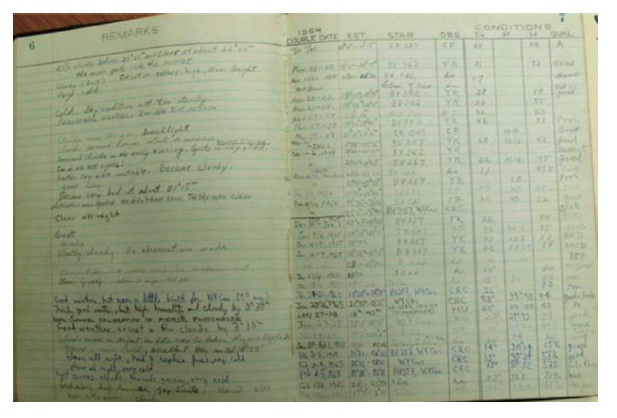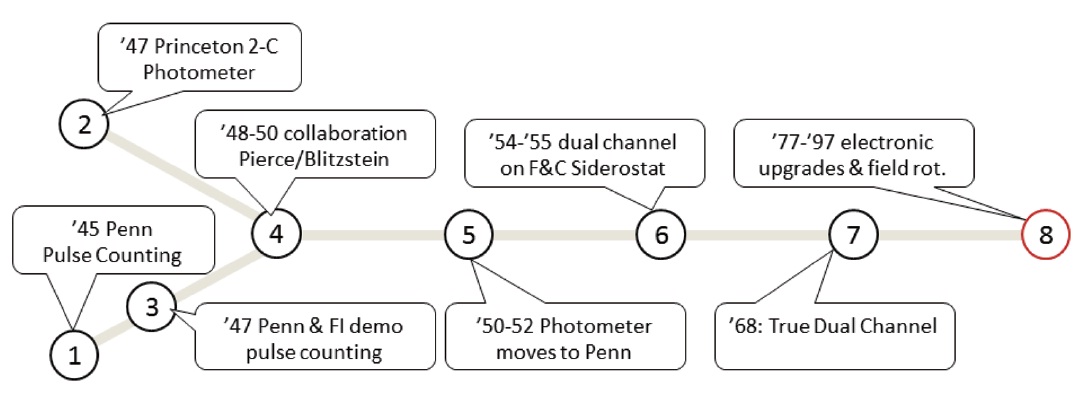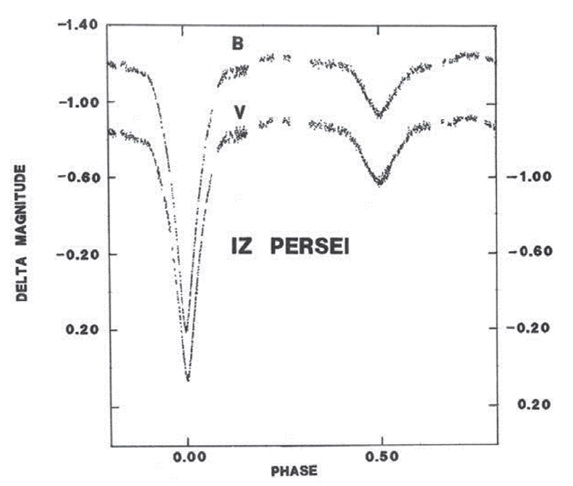



The dual channel Pierce-Blitzstein photometer (PBPHOT) was productively used at the Flower and Cook Observatory to provide 60 years of study of binary systems and other cosmic objects. We review the history of this instrument, discuss its calibration, and recall some personal and professional interactions with Professor Robert H. Koch.
Several of us worked with Bob Koch to produce a fairly comprehensive technical description of Pierce-Blitzstein photometer (PBPHOT, Fig. 1), a photometric instrument well ahead of its time, and productively used at the University of Pennsylvania’s Flower and Cook Observatory for nearly 6 decades (Figs. 2 and 3). Since it could work accurately through magnitudes of variable extinction, it was ideally suited for the suburban Philadelphia location of Flower and Cook Observatory. In 2008, author Hull noticed the announcement by Gene Milone of a special historical astronomy division (HAD) session at the January 2009 American Astronomical Society (AAS) meeting in Long Beach, CA entitled “Photometry: Past, Present and Future.” This immediately brought to mind PBPHOT, an instrument Hull had first used as a freshman at Pennsylvania in 1962, and he called Carol Ambruster to propose that we do a paper with Bob Koch. Carol called Bob, who was immediately supportive and enthusiastic. More than that, he had collected an encyclopedic account of the full history
of PBPHOT, even extending back to the early roles of Lyman Spitzer and Newton Lacy Pierce in this instrument. With Bob, we extended this further (Ambruster et al. 2011) to constitute a chapter in the recently-published book on astronomical photometry from the 2009 HAD session (Milone & Sterken 2011). This chapter involved extensive
interaction with Bob, and exhibits his style and love of this instrument. Fig. 4 summarized the development history of the instrument. It may be argued that no one over the years has done more for PBPHOT than Bob Koch, a fact that may not have been apparent from the published version of this history. We have elected not to rewrite the original article, which had so much the hand of Bob in it. We refer you to this book for a detailed account of PBPHOT, as well as a fairly concise history of astronomical photometry in general. Material presented here augments that chapter, and is meant to be used in conjunction with the chapter. We use this discussion to describe working with Bob on the oral paper and the chapter, and as an opportunity to provide further information on the instrument. We also appreciate additional material provided by George Wolf on his Master’s
work at University of Pennsylvania (Wolf 1967), which adds an important step to the timeline: the calibration procedure that, for the first time, allowed true dual channel, pulse-counting photometry.
2. WORKING WITH BOB TO PRODUCE THE MAJOR PBPHOT PAPER BY THE PRESENT AUTHORS
We all had the opportunity to work with Bob either in the capacity of his Chairmanship of the University of Pennsylvania Astronomy Department and director of Flower and Cook Observatory, or as an employee. So this was not a level relationship. Bob always had clear ideas on how things should be done. Even at the end of his career, and with the rest of us in advanced careers, we responded to his leadership throughout the writing effort. Bob had an immense amount of information at his command. Even though several of us thought we knew the instrument fairly well, we were often surprised by the detailed facts which Bob, who had management cognizance over the instrument for several decades, could easily recite. We became aware of how much Bob valued this instrument: as an asset to astronomy, a serious research tool for many of the graduate students in University of Pennsylvania Astronomy, and for his own personal research. Nevertheless, Bob never brought attention to himself and his role, always deferring to Bill Blitzstein and those who had worked with Bill to keep this an efficient instrument. Even after losing Bill (in 1999), when
Bob was the prime driver for keeping PBPHOT scientifically relevant, never did he bring attention to himself. We would like it to be on record that through Bob’s drive, initiative and professional insight, later planned improvements actually got implemented, resulting in the exceptional timeline for this fine instrument. In fact, after the demise of Flower and Cook Observatory, PBPHOT was acquired by another observatory. It is not impossible that we will see work from it once again.
Early use of the photometer was fairly informal, and mostly reported in personal notebooks of observers. In 1964, it was decided that a proper log should be kept of all work done on PBPHOT. These records have been invaluable to our historic look backwards. The log was maintained throughout the remaining decades of observations with PBPHOT. Remarkably, the vast majority of the (mostly graduate student) PBPHOT observers listed in Fig. 2 went on to professional careers in astronomy or closely related fields, including almost all the organizers (and a number of the attendees) of the “Stars, Companions and their Interactions: A Memorial to Robert H. Koch” conference held at Villanova University in August 2011.
3. TRUE DUAL CHANNEL USE OF PBPHOT
Just prior to this August 2011 Koch Memorial Conference, George Wolf identified a major omission in our earlier paper: the role of his MS thesis under Bill Blitzstein, in performing the calibration work necessary to make PBPHOT a true two channel photometer, and finally fulfilling the vision of Newton L. Pierce (1905-1950) and especially Bill Blitzstein (1920-1999). Between 1955 and 1965 the PBPHOT was used regularly for photometry, but only in single-channel mode. The systematic errors between the two channels had never been analyzed in order to calibrate and use the full two-channel capabilities of the instrument. In order to remedy this situation, in 1965 George Wolf began a two year MS thesis study of PBPHOT to characterize, calibrate and (wherever possible) eliminate all impediments to two-channel photometry.
Between 1965 and 1967, Wolf added an incandescent light source with color-temperature correction filters (which could roughly mimic black bodies from 2,800 K to 45,000 K) and an opal diffuser on its front side was used to illuminate the objective of the 15” siderostat. This light source could be put into the optical path of the telescope at the objective and observed by both channels simultaneously, as needed to calibrate out any channel sensitivity differences and variations over time. The two 1P21 multiplier photocells in the photometer heads were replaced with a new pair matched for color, absolute sensitivity, and for stability. In addition, the photocell mounts were stiffened to avoid
flexure as the heads were moved and rotated. Also the rotation axis of the entire photometer was carefully aligned with the optical axis of the telescope. This eliminated channel-ratio changes as the heads were rotated to keep up with the field-of-view rotation of the siderostat during the night. Filter slides with detents and matched color filters were added to each channel for quick and accurate filter changes. The paper tape data recording was replaced with an automated IBM card punch data recording system. These changes led to increased accuracy compared to single channel photometry, and a 100% increase in the number density of observations during a night. The latter advantage of PBPHOT was brought home to author Ambruster during observing runs in the l980’s and early 1990’s at the KPNO #2 36-inch telescope using their excellent, computer-controlled single-channel photometer. So much precious observing time was lost to overhead observations (standard stars, etc.)! Fig. 5 shows the light curve of IZ Persei obtained between 1967 and 1970, the first long-term test of the usefulness and stability of Pierce-Blitzstein photometer in two-channel mode.
The authors are pleased to assure in this volume that Bob Koch’s true contribution to this marvelous instrument is recognized. Additional data has been provided which will be of interest to the many who have used this instrument. We are also pleased to have updated the record about George Wolf’s contribution to the dual channel calibration of PBPHOT. It has been an honor to work with Bob Koch in establishing the history of this instrument where his hand was so evident. We also than Bruce Holenstein for providing additional photographs, especially the logs.
